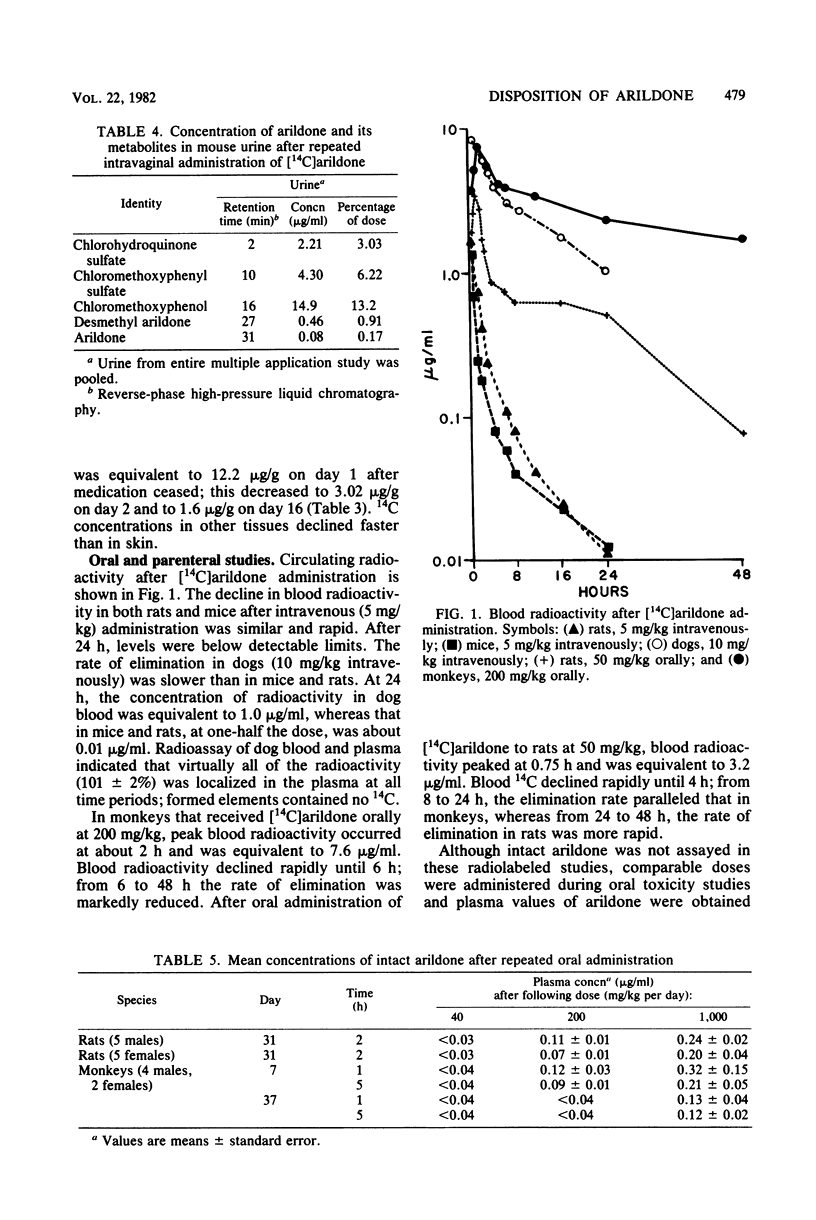Abstract
[14C]arildone was administered both topically and intravaginally to mice 5 times a day for 7 days to simulate conditions of clinical usage. Urinary and fecal excretion of radioactivity indicated that arildone was extensively absorbed by both routes of administration. The levels of radioactivity in the vagina and skin declined from about 12 micrograms equivalents per g to 3 micrograms equivalents per g between 1 and 2 days after the last application. Only small amounts of unchanged arildone were found in urine from the vaginally treated animals; the major urinary metabolites were chloromethoxyphenol, its sulfate ester, and chlorohydroquinone sulfate. After about 1 month of daily oral administration of arildone to rats and monkeys or vaginal administration three times a day for 20 days to dogs, only low levels of intact drug were found in the systemic circulation. The disposition or beta-phase half-life of arildone in monkeys after intravenous administration was about 0.5 h. The disposition of [14C]arildone in mice, rats, dogs, and monkeys after various routes of administration was also investigated.
Full text
PDF






Selected References
These references are in PubMed. This may not be the complete list of references from this article.
- Benziger D. P., Fritz A. K., Clemans S. D., Edelson J. Metabolism of arildone, an antiviral agent, in laboratory animals. Drug Metab Dispos. 1981 Sep-Oct;9(5):424–427. [PubMed] [Google Scholar]
- Caliguiri L. A., McSharry J. J., Lawrence G. W. Effect of arildone on modifications of poliovirus in vitro. Virology. 1980 Aug;105(1):86–93. doi: 10.1016/0042-6822(80)90158-0. [DOI] [PubMed] [Google Scholar]
- Diana G. D., Salvador U. J., Zalay E. S., Carabateas P. M., Williams G. L., Collins J. C., Pancic F. Antiviral activity of some beta-diketones. 2. Aryloxy alkyl diketones. In vitro activity against both RNA and DNA viruses. J Med Chem. 1977 Jun;20(6):757–761. doi: 10.1021/jm00216a004. [DOI] [PubMed] [Google Scholar]
- Diana G. D., Salvador U. J., Zalay E. S., Johnson R. E., Collins J. C., Johnson D., Hinshaw W. B., Lorenz R. R., Thielking W. H., Pancic F. Antiviral activity of some beta-diketones. 1. Aryl alkyl diketones. In vitro activity against both RNA and DNA viruses. J Med Chem. 1977 Jun;20(6):750–756. doi: 10.1021/jm00216a003. [DOI] [PubMed] [Google Scholar]
- Kim K. S., Sapienza V. J., Carp R. I. Antiviral activity of arildone on deoxyribonucleic acid and ribonucleic acid viruses. Antimicrob Agents Chemother. 1980 Aug;18(2):276–280. doi: 10.1128/aac.18.2.276. [DOI] [PMC free article] [PubMed] [Google Scholar]
- Kuhrt M. F., Fancher M. J., Jasty V., Pancic F., Came P. E. Preliminary studies of the mode of action of arildone, a novel antiviral agent. Antimicrob Agents Chemother. 1979 Jun;15(6):813–819. doi: 10.1128/aac.15.6.813. [DOI] [PMC free article] [PubMed] [Google Scholar]
- McSharry J. J., Caliguiri L. A., Eggers H. J. Inhibition of uncoating of poliovirus by arildone, a new antiviral drug. Virology. 1979 Sep;97(2):307–315. doi: 10.1016/0042-6822(79)90342-8. [DOI] [PubMed] [Google Scholar]
- Park G. B., Erdtmansky P., Kullberg M. P., Edelson J. The analysis of arildone in plasma, urine and feces by gas--liquid chromatography with electron-capture detection. J Chromatogr. 1981 Feb 13;222(2):213–223. doi: 10.1016/s0378-4347(00)81054-3. [DOI] [PubMed] [Google Scholar]


